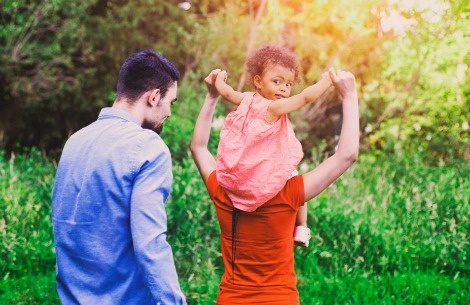Transracial adoption is a choice that needs more thought put into it than people think. When hoping to grow their family through adoption, many couples want to open themselves to as many possibilities as possible. Being open to a baby of a different race can seem like an easy choice. Why would the color of a baby’s skin matter?
The answer can be a little more complicated and will involve looking at your environment and personality to decide if it is the right choice for you, but more importantly, for the child.
How Can We Have a Healthy Transracial Adoption?
Successful transracial adoptions stem from families who educate themselves and acknowledge that they may not fulfill every aspect of their children’s needs. It’s important for these families to recognize that their adopted children may benefit from connecting with others who share their racial background.
Currently, 40% of adoptions are transracial. While this makes transracial families more common, you will still need to be ready to deal with being a conspicuous family. Shares Isaac Etter, an adoptee and the Founder of Identity, “It wasn’t super difficult to feel like we were family. A lot of the time it was more difficult to feel like I wasn’t the only one having my own experience, if that makes sense. So, it felt more like, yes, that’s my sister, but I’m having to explain how that’s my sister or notice people kind of take a second glance. When you’re in a situation like transracial adoption, you’re kind of like the sore thumb out. It’s like you see a family picture, was kind of like an evident stick out, and that was a lot of my early life.”
For example, when you walk into a restaurant or down the street, people may ask inappropriate questions or comment. How much you will deal with this will, for the most part, depend on where you live, but it’s important to prepare yourselves to handle them.
Tips for a Successful Transracial Adoption
If you’re interested in transracial adoption, there are essential elements to follow so that you can help your child thrive. A few of these include learning about and respecting your child’s culture and finding ways to support their connections to it.
Here are 4 tips on how you can have a successful transracial adoption:
- Talk to Family and Friends
When you’re wondering if adopting outside of your race is right for you, connect with your family about what becoming a multiracial family will look like. How will they react to the changes your adoption will bring? Are members of your extended family excited about your decision to adopt, and ready to support you and your child? Do you live in a community that appreciates diversity? Is the community likely to accept the child you bring into your family?
- Hear from Those With Adoption Experience
It helps to learn from other adoptive parents if you’ve considered transracial adoption, especially regarding life after adoption. Check out this webinar, highlighting the experience of three Lifetime adoptive moms, each with a different story of transracial adoption.
There are also some great books out there that you can use to learn more about transracial adoption, including:
- What White Parents Should Know about Transracial Adoption: An Adoptee’s Perspective on Its History, Nuances, and Practices
- I’m Chocolate, You’re Vanilla: Raising Healthy Black and Biracial Children in a Race-Conscious World
- In Their Voices: Black Americans on Transracial Adoption
- Inside Transracial Adoption
Remember, transracial adoption isn’t just when “a Caucasian couple adopts an African American child.” If you are open to adopting a child who may not share race in common with you, it’s important to learn as much as possible on this side of your adoption story. Lifetime’s Transracial Adoption Q&A webinar is a great place to start!
- Consider Role Models for Your Child
Your child will naturally turn to you for guidance because you’re the parent. But they’ll probably have questions related to their race and culture that you can’t answer or issues that you can’t understand. Consider including adults in your child’s life who share their culture. It will give them the asset of positive role models!
- Make Connections
Adopting a child of a different race is an excellent opportunity to explore new resources and get involved with groups in your community. Consider:
- Seeking diverse schools in your district where you can enroll your future child.
- Participating in groups dedicated to racial justice.
- Joining a faith community that matches your adopted child’s heritage.
- Making connections with other transracial adoptive families with children.
- Hear from Adoptees
Learning about adoption is best done through the experiences of adopted individuals. I strongly advocate that incorporating their voices into adoption training and education should be a standard practice.
For many adoptees, discussing adoption can be emotionally challenging, stirring uncomfortable feelings. This difficulty amplifies for transracial adoptees, given the noticeable differences between them and their adoptive families.
Adoptees hold invaluable perspectives and a wealth of knowledge beneficial to adoptive parents, prospective families, adoption experts, and the broader community. In his documentary Discovering My Identity, transracial adoptee Isaac Etter candidly shares his journey:
Isaac Etter established Identity with the mission to empower foster and adoptive families, particularly focusing on transracial adoption. Adopted himself at two years old, Isaac’s dedication embodies a profound commitment to transforming the landscape of adoption. Through his narrative, Isaac endeavors to assist transracial adoptive parents in guiding their children through the intricate journey of shaping their individual and racial identities.
“Most people growing up are trying to figure out who they are…but I think adoptees are struggling with so many layers of it because they’re trying to figure out who they are as adopted people who may or may not know their biological family and then transracial adoptees are struggling with this other layer, which is like, ‘Who am I if I don’t know other people that look like me?’” says Etter.
Determine if Transracial Adoption is Right for Your Family
We might hope that those around us are color-blind, and that racism is rare. Unfortunately, the reality is it exists, and in certain communities, it is common. You need to take a good and honest look at your community. As you consider if a child of another race would thrive in your community, here are some questions you might ask yourselves:
- Is there a decent amount of diversity where you live?
- If you do not live in a diverse area, would you be willing to move?
- Are there community role models and friends of the same race as the child?
- Do you feel ready to acknowledge and talk to your child about racism as they grow?
- Are your neighborhood schools and churches diverse?
- Are you willing to research and embrace the traditions of your child’s race?
- Will your friends and family be accepting of a baby of another race?

If you answer “no” to any of these questions, does that mean you should not adopt a baby of another race? Maybe not, but you will need to prepare yourselves to offset any of the negatives of your situation.
If you do not live in a diverse area, you will need to go out of your way to find and connect with role models and friends for your child. You may want to consider adopting a sibling group. There are ways to overcome some of these issues with planning and determination.
Potential Issues and How to Handle Them
As your child grows older and notices the difference in your skin color, it is important to acknowledge and celebrate your differences.
There are excellent resources available on the Child Welfare Information Gateway’s website. In addition, there are several amazing books out there for children of all ages. Start reading these to your child from a very early age. It will help your child open up and ask the questions they might have but aren’t sure how to express. Some books we recommend include:
- We Match on the Inside: A book to help your child answer questions about adoption
- Beautiful Shades of Blue
- Mommy and Me Don’t Match

Be your child’s most prominent advocate and never tolerate racist statements or attitudes. You will need to make sure your child feels safe to share their feelings, ask questions, and know that whatever their emotions and fears are, you take them seriously. Although you may not know exactly what they feel, you can tell them you support them and take any concerns seriously.
Transracial adoption can be a beautiful, life-enriching way to grow your family. You can smooth out some of the road bumps by preparing for issues before they occur. Families come in all shapes, sizes, and colors. We should celebrate all and acknowledge their beauty.
Encourage Your Child’s Heritage
Adoptive parents must celebrate their adopted children’s culture and heritage to help them become proud of who they are. Learning about their heritage helps your child understand their origins and develop positive self-esteem.
How can you effectively combine your child’s culture with your family’s after the adoption? Here are four tips on how to encourage your child’s heritage in a transracial adoption:
- Associate With Others
A culture camp, playgroup, sport, or dance class are places that’ll help your child connect with other children. These activities can assist in bringing your child together with others who share the same experience of being adopted.
It will help your child to see kids whose families look like theirs and who face the same challenges. Meeting up regularly with other adopted children can help them find a place where they belong.
- Practice Multiculturalism Every Day
Activities recognizing your child’s heritage should occur daily, not just during special events or holidays. You can practice multiculturalism regularly in simple ways: maybe it’s cooking some traditional meals each week or watching shows and movies with characters from your child’s background.
- Focus on Your Child’s Preferences
Many couples who became parents through transracial adoption seem to focus on traditional foods or attire. But what’ll make this celebration of culture special to your child is to tailor it to them.
Think about your child’s interests when you plan cultural activities. For example, if your son or daughter is artistic, you might take him to an art gallery showcasing work from an artist who shares their heritage. If they’re into movies, take your child to a show that represents their race positively. One adoptive mother, Hayley, shares, “Our daughter loves going to her weekly ballet class! So, we recently took her to see a Misty Copeland performance.”
- Keep Balanced
Even though it’s excellent to incorporate all this cultural education, some adoptive parents get a little too intense about making sure their child learns about their birth heritage. Remember to tailor things to your child’s interests and needs. If your child’s calendar is completely booked with cultural activities, take a step back.
How Lifetime Adoption Helps With Transracial Adoption
Lifetime Adoption has helped many hopeful parents adopt a child of a different race, preparing them with the proper training and resources to address their child’s racial identity successfully.
If you think transracial adoption might be right for you, please don’t hesitate to contact Lifetime at 727-493-0933 to learn more and start the process whenever you’re ready.
Editor’s Note: This article was originally published on October 6, 2021, and has since been updated.
Founder of Lifetime Adoption, adoptive mom, adoption expert, and Certified Open Adoption Practitioner (C.O.A.P).
Since 1986, adoption expert Mardie Caldwell has been dedicated to bringing couples and birth parents together in order to fulfill their dreams.
“Many years ago, I was also searching for a child to adopt. We didn’t know where or how to get started. Through research, determination, and a prayer, our dream of a family became reality. I started with a plan, a notebook, assistance from a caring adoption consultant and a lot of hard work; this was my family I was building. We had a few heartaches along the way, but the pain of not having children was worse!
Within weeks we had three different birth mothers choose us. We were overwhelmed and delighted. Many unsettling events would take place before our adoption would be finalized, many months later. Little did I know that God was training and aligning me for the adoption work I now do today. It is my goal to share with our families the methods and plans which succeed and do not succeed. I believe adoption should be affordable and can be a wonderful “pregnancy” for the adoptive couple.
I have also been on both sides of infertility with the loss of seven pregnancies and then conceiving by new technology, giving birth to a healthy daughter. I have experienced first-hand the emotional pain of infertility and believe my experience allows me to serve your needs better.
It is my hope that for you, the prospective parents, your desire for a child will be fulfilled soon.”






we are considering to adopt a transracial baby from mr neill and mrs shelly hill
Hello Mr. and Mrs. Hill,
If you’d like to learn more about adopting through Lifetime, please call us at 1-800-923-6784. Also, you can take the first step in the adoption process today, by filling out Lifetime’s free online application to adopt!